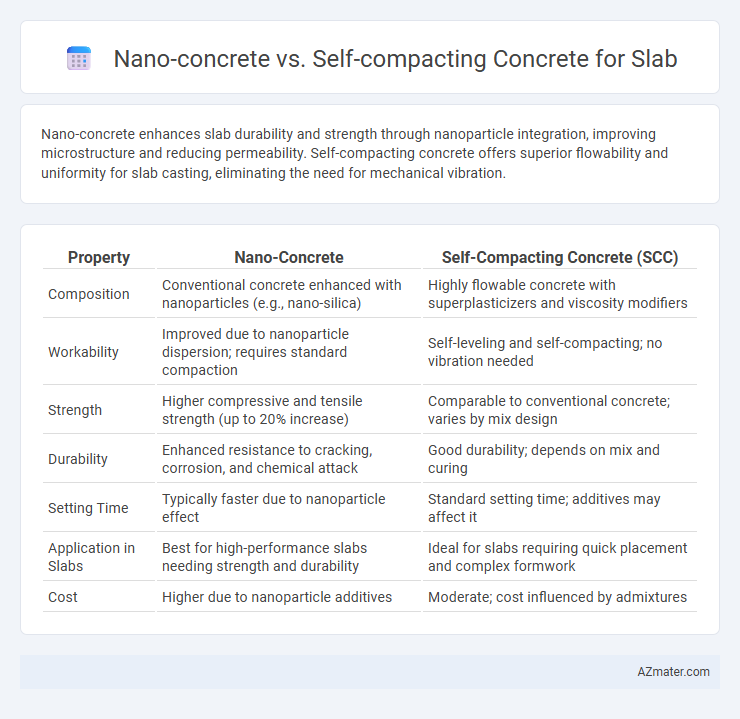Nano-concrete enhances slab durability and strength through nanoparticle integration, improving microstructure and reducing permeability. Self-compacting concrete offers superior flowability and uniformity for slab casting, eliminating the need for mechanical vibration.
Table of Comparison
| Property | Nano-Concrete | Self-Compacting Concrete (SCC) |
|---|---|---|
| Composition | Conventional concrete enhanced with nanoparticles (e.g., nano-silica) | Highly flowable concrete with superplasticizers and viscosity modifiers |
| Workability | Improved due to nanoparticle dispersion; requires standard compaction | Self-leveling and self-compacting; no vibration needed |
| Strength | Higher compressive and tensile strength (up to 20% increase) | Comparable to conventional concrete; varies by mix design |
| Durability | Enhanced resistance to cracking, corrosion, and chemical attack | Good durability; depends on mix and curing |
| Setting Time | Typically faster due to nanoparticle effect | Standard setting time; additives may affect it |
| Application in Slabs | Best for high-performance slabs needing strength and durability | Ideal for slabs requiring quick placement and complex formwork |
| Cost | Higher due to nanoparticle additives | Moderate; cost influenced by admixtures |
Introduction to Advanced Concrete Technologies
Nano-concrete incorporates nanoparticles to enhance microstructure, resulting in superior compressive strength and durability compared to traditional concrete. Self-compacting concrete (SCC) flows under its own weight, eliminating the need for mechanical vibration and ensuring uniform compaction, particularly beneficial for complex slab forms. Both advanced technologies significantly improve slab performance, with nano-concrete optimizing material properties at the nanoscale and SCC enhancing workability and surface finish quality.
Understanding Nano-Concrete: Properties and Benefits
Nano-concrete incorporates nanomaterials like nanosilica, enhancing its microstructure to achieve superior strength, increased durability, and improved resistance to cracking compared to traditional self-compacting concrete. This advanced composite exhibits a refined pore structure, which reduces permeability and improves long-term performance under mechanical and environmental stress. Key benefits for slab applications include higher compressive strength, rapid setting times, and enhanced workability, making nano-concrete an innovative alternative for high-performance construction.
Overview of Self-Compacting Concrete (SCC)
Self-Compacting Concrete (SCC) is a highly fluid, non-segregating mix designed to flow and consolidate under its own weight without the need for mechanical vibration, making it ideal for slab applications with complex reinforcement. Its optimized particle packing and use of superplasticizers improve workability, reduce labor costs, and enhance surface finish quality compared to traditional concrete. SCC's ability to achieve uniform density and superior durability in slabs contributes to increased structural performance and longevity in construction projects.
Key Differences: Nano-Concrete vs Self-Compacting Concrete
Nano-concrete incorporates nanoparticles to enhance mechanical properties such as strength, durability, and resistance to micro-cracking, whereas self-compacting concrete (SCC) emphasizes high flowability and ease of placement without segregation or bleeding. Nano-concrete's nanoparticles modify the microstructure for improved hydration and reduced porosity, while SCC relies on optimized mixture designs with superplasticizers and viscosity modifiers for superior workability. In slab applications, nano-concrete offers enhanced long-term performance and resistance to environmental degradation, whereas SCC provides faster construction and better surface finish due to its self-leveling characteristics.
Strength and Durability Comparison for Slab Applications
Nano-concrete exhibits superior strength and durability compared to self-compacting concrete in slab applications due to its enhanced microstructure and reduced porosity from nano-silica additives. The incorporation of nanoparticles improves the hydration process, resulting in higher compressive and tensile strength values, which contribute to better load-bearing capacity and crack resistance. Self-compacting concrete offers excellent flowability and ease of placement, but may fall short of nano-concrete's long-term durability performance in aggressive environmental conditions.
Workability and Placement Efficiency
Nano-concrete offers superior workability due to its enhanced particle packing and reduced porosity, allowing for smoother flow and easier placement in slab construction. Self-compacting concrete (SCC) is specifically designed for high fluidity without segregation, enabling rapid and efficient placement in complex formworks and congested reinforcement areas. Both materials improve placement efficiency, but SCC excels in large-scale projects requiring consistent flow, while nano-concrete provides strength and durability benefits alongside improved workability.
Cost Implications and Material Availability
Nano-concrete incorporates nanoparticles that enhance strength and durability but often involves higher costs due to specialized materials like nano-silica and limited local availability. Self-compacting concrete, favored for its ease of placement without vibration, typically offers cost savings in labor and equipment but may require premium admixtures that affect pricing and sourcing. Material availability for nano-concrete remains restricted to advanced suppliers, while self-compacting concrete ingredients are more universally accessible, influencing overall project budgeting and procurement timelines.
Sustainability and Environmental Impact
Nano-concrete incorporates nanoparticles that enhance durability and reduce material consumption, significantly lowering carbon footprints in slab construction compared to traditional mixes. Self-compacting concrete (SCC) eliminates the need for mechanical vibration, reducing energy use and noise pollution on-site while maintaining high performance and workability. Both materials contribute to sustainable construction, but nano-concrete's potential for longer service life and reduced resource demand offers a more impactful environmental benefit for slab applications.
Case Studies: Slab Performance in Real Projects
Case studies reveal that nano-concrete slabs exhibit superior durability and enhanced microstructural properties, resulting in increased resistance to cracking and improved load-bearing capacity compared to self-compacting concrete (SCC). Slabs constructed with nano-concrete demonstrate reduced shrinkage and better long-term performance under dynamic loads in high-traffic infrastructure projects. In contrast, SCC slabs offer advantages in workability and faster placement but may require additional curing measures to match the mechanical strength and longevity observed in nano-concrete applications.
Choosing the Right Concrete for Your Slab
Nano-concrete integrates nanoparticles that enhance mechanical strength and durability, making it ideal for slabs exposed to heavy loads and environmental stress. Self-compacting concrete offers superior workability and uniform compaction without mechanical vibration, reducing labor and ensuring a smooth finish for slab applications. Selecting the right concrete depends on the project's structural requirements, environmental conditions, and labor resources, with nano-concrete suited for high-performance demands and self-compacting concrete preferred for efficient, high-quality slab construction.

Infographic: Nano-concrete vs Self-compacting concrete for Slab
 azmater.com
azmater.com